
Frankfurt 2004
Page 4
| After my trip to Ghana, I flew to Frankfurt, The Land of My Birth, for several days of fun in the Hessen. I was given a very warm welcome by Karsten and his wife Sabina. |
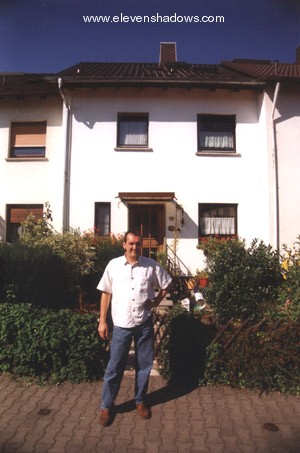 Karsten,
the son of the woman who helped take care of me when I lived in
Germany, standing in front of the house where I lived as a tiny pup. Karsten,
the son of the woman who helped take care of me when I lived in
Germany, standing in front of the house where I lived as a tiny pup. |
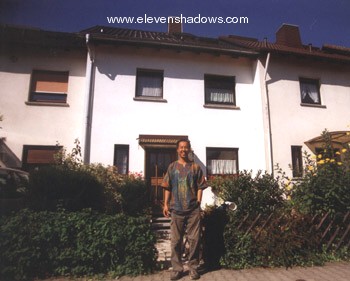 In
front of the same home. In
front of the same home. |
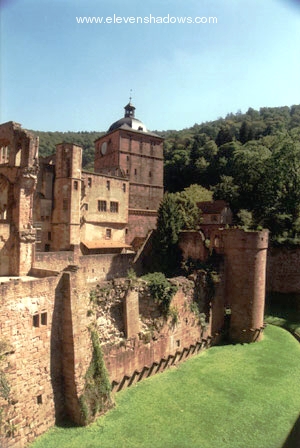 Heidelberg
Castle. Heidelberg
Castle. |
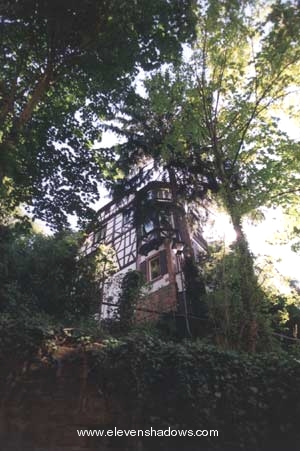 Heidelberg
Castle near Frankfurt, Germany. Heidelberg
Castle near Frankfurt, Germany. |
 Burg
Frankenstein sits quietly on the edge of the Northern foothills of the
Magnetberg mountain range near Darmstadt, Germany, and were preparing for
Halloween festivities when we visited. Burg
Frankenstein sits quietly on the edge of the Northern foothills of the
Magnetberg mountain range near Darmstadt, Germany, and were preparing for
Halloween festivities when we visited.For more information. |
 Rüdesheim,
where Karsten and I visited the medieval Torture Museum and Siegfried’s
Mecanische Musikkabinet Museum, (right) home of numerous gargantuan
motor-driven musical instruments. Rüdesheim,
where Karsten and I visited the medieval Torture Museum and Siegfried’s
Mecanische Musikkabinet Museum, (right) home of numerous gargantuan
motor-driven musical instruments.One remarkable instrument there was an instrument plays six actual violins that accompany the piano. I didn't scan this picture, so the only way for you to see it is for either for you to go to the museum or to come over to my house and look at my photo album. |
 St.
Hildegarde’s Abbey, above Rüdesheim and the Rhine river. At a time when few
women wrote, Hildegard Von Bingen produced major works of theology and
visionary writings. She was considered a visionary, seer, and prolific
writer on mystical, medical and political subjects, and was born at
Böckelheim, Germany in 1098. St.
Hildegarde’s Abbey, above Rüdesheim and the Rhine river. At a time when few
women wrote, Hildegard Von Bingen produced major works of theology and
visionary writings. She was considered a visionary, seer, and prolific
writer on mystical, medical and political subjects, and was born at
Böckelheim, Germany in 1098.
She is called the Sibyl of the Rhine and was abbess of the nunnery of Diessenberg, Lorraine, where she was bought up. She founded the abbey of St Rupert, near Bingen. Under the directions of her confessor she recorded some of her visions. Her Scivias, divided into three books, containing 26 visions, also contains denunciations of the vices of the world and prophesies of disaster. She exerted a wide influence in political and religious matters in her time, and was also a noted composer. |
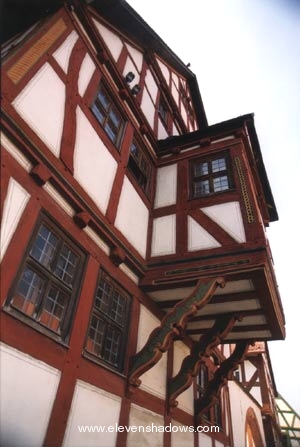 Hessenpark
is an open-air museum of real buildings from the state of Hessen located
Taunus Mountains just north of Frankfurt. The buildings are the traditional
Fachwerkhaus style. Hessenpark
is an open-air museum of real buildings from the state of Hessen located
Taunus Mountains just north of Frankfurt. The buildings are the traditional
Fachwerkhaus style.
Visitors to the Hessenpark can explore a variety of dwellings, houses of worship, mills and more from the past 400 years. The buildings, removed from their original sites in villages all over Hessen, have been meticulously restored and refurnished to give modern-day visitors an idea of what rural life was like before, during and after the industrial revolution. |
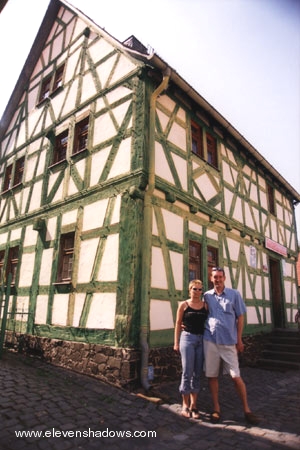 Karsten
and his wife Sabina, two very important visitors to Hessenpark, contemplate
how life may have been had they been born hundreds of years ago. Karsten
and his wife Sabina, two very important visitors to Hessenpark, contemplate
how life may have been had they been born hundreds of years ago. |
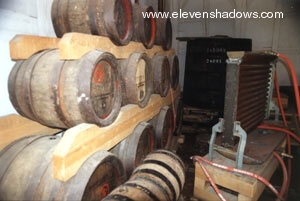 An
old brewery in Hessenpark. While in Germany, Karsten took me to several
biergartens to sampletheir fine brew. I tried several
kinds of pilsner, and was impressed by their freshness and taste. An
old brewery in Hessenpark. While in Germany, Karsten took me to several
biergartens to sampletheir fine brew. I tried several
kinds of pilsner, and was impressed by their freshness and taste.And for some reason, people here keep asking if their beer was warm. No, it was not. Ever. It was always served cold. Warm beer sucks. Got it? |
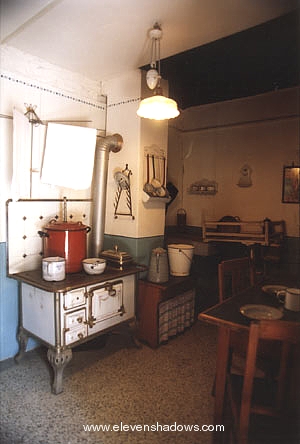 Hessenpark.
I believe this kitchen depicts a German kitchen from the 1950s. It was taken
without a flash by balancing my camera on the railing, clicking, and hoping
for the best. Hessenpark.
I believe this kitchen depicts a German kitchen from the 1950s. It was taken
without a flash by balancing my camera on the railing, clicking, and hoping
for the best. |
 A
church. I can't remember what era. I do remember that it's yet another of
those startling recreations in Hessenpark, and that people were practicing
medieval songs upstairs. A
church. I can't remember what era. I do remember that it's yet another of
those startling recreations in Hessenpark, and that people were practicing
medieval songs upstairs. |
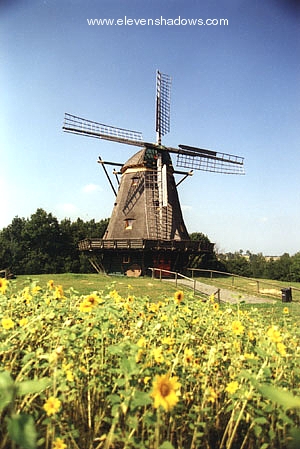 Hessenpark. Hessenpark.
See all the wonderful structures you can see at Hessenpark?
You can't possibly tell me that you're not impressed. I could have very
easily told you that I had traveled all over Germany taking these pictures.
But instead, I was honest, 'fessed up, and told you that it was all at
Hessenpark. |
 This
is not Karsten's horse. In fact, it's not a horse at all. No, this is a
sweet lovable animal who only wants to make you happy by posing for pictures
in Hessenpark. This
is not Karsten's horse. In fact, it's not a horse at all. No, this is a
sweet lovable animal who only wants to make you happy by posing for pictures
in Hessenpark.~~~~~~~~~~~ Feeling deeply satisfied after reconnecting with my German roots, I reflected on my Hessian heritage during my 11-hour flight home in coach. |
Frankfurt 2004
Page 4
Ghana and
Frankfurt Home Page
Eleven Shadows Travel Page
Contact photographer/musician Ken Lee